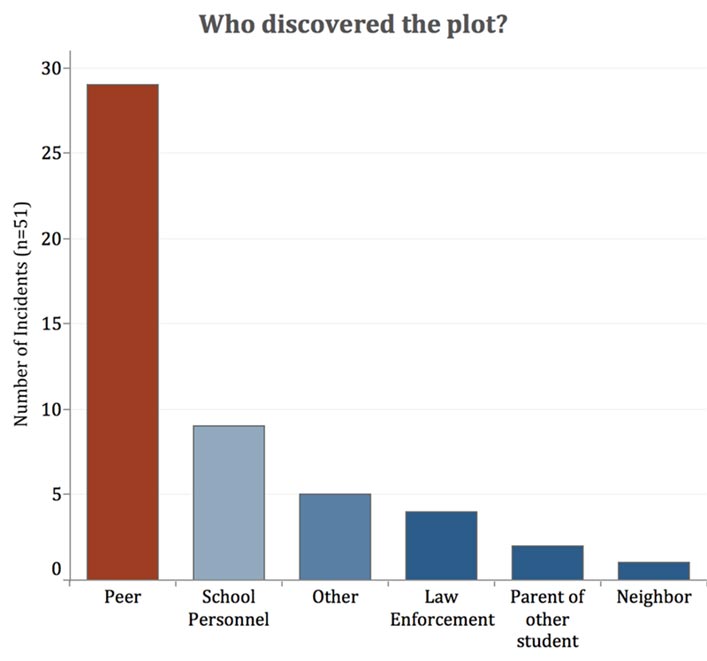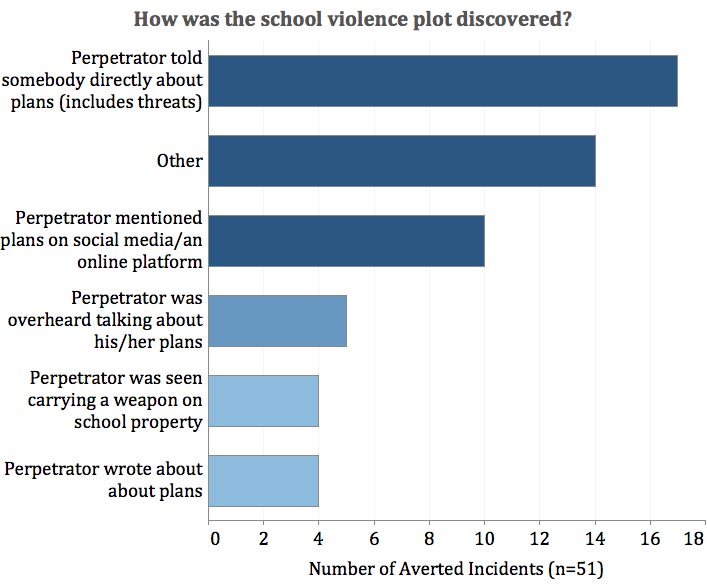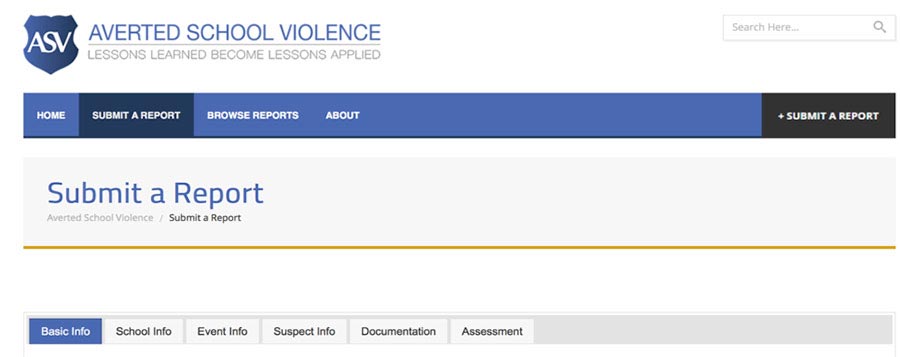Contact Us
To provide feedback on the Community Policing Dispatch, e-mail the editorial board at CPDispatch@usdoj.gov.
To obtain details on COPS Office programs, publications, and resources, contact the COPS Office Response Center at 800-421-6770 or AskCopsRC@usdoj.gov

U.S. Department of Justice
Office of Community Oriented Policing Services
Washington, DC 20530
The Police Foundation—a national non-profit, non-partisan organization dedicated to improving policing through innovation and science—initiated a project, with funding from the U.S. Department of Justice Office of Community Oriented Policing Services, to study “averted acts of school violence.” The project is based on the concept of the “near miss,” which has been used to inform business practices in the aviation, fire, and medical professions. The near miss concept holds that for every incident that occurs, there are significantly more averted incidents. These averted incidents contain invaluable information regarding the strengths or potential weaknesses of policies, procedures, training, and practices.
The Police Foundation has built a national averted school violence database. This database collects and analyzes data regarding averted incidents to identify best, and more importantly, “next” practices to prevent and respond to acts of mass violence on our campuses.
Definition of Averted School Violence
The Police Foundation defines an averted school violence incident as a violent attack, planned with or without the use of a firearm, that was prevented either before or after the potential perpetrator arrived on school grounds, before any injury or loss of life occurred.
What Are Some of the Lessons We Have Learned?
Police Foundation subject matter experts have reviewed incident reports of 51 averted and 51completed attacks recorded in the averted school violence database. Averted and completed incidents were identified from open source news stories, court documents, and individuals who had personal knowledge of the incidents.
To date, the team has identified the following lessons learned:
- Schools and law enforcement must have a strong, pre-established relationship and open lines of communication before an attack occurs.
- Students who hear threats of violence from other students should take them seriously and report them to school or other authorities immediately. In over half of the incidents we studied, students were the first to discover another student’s plans for school violence (see Figure 1).

Figure 1: Who discovered the plot? - Students should be trained not only to recognize threats of violence, but also to recognize signs of suicide or depression.
- Parents should monitor their children’s social media accounts for any concerning searches or violent material and remain aware of their general Internet use.
- Potential perpetrators of violence frequently make direct threats or openly discuss their violent plans with others. In some instances, they use social media platforms such as Facebook, Instagram, and even Snapchat to share violent plans or thoughts, or to express disdain for a school or situation (see Figure 2).

Figure 2. How was the school violence plot discovered? - Parents should take their children’s threats of violence seriously and seek assistance from law enforcement, mental health professionals, and other service providers.
- Parents should keep all guns in a locked and secure location.
- School personnel, school resource officers, and campus police and security officers should strive to develop and maintain rapport with students so they are aware of students who are bullied, feel excluded, depressed, or challenged in other ways so they can connect them to services.
- Schools must continuously update and practice their emergency communication systems and response plans.
- Schools should have a plan in place for timely communication of incidents to parents.
- Schools, particularly universities and higher education, should be aware that financial distress can be a trigger for violence.
- Schools should notify all staff when a student is suspended or expelled. That student should not be allowed back on campus the same day of the suspension or expulsion.
- Schools should direct concerns through a “safety team” for review and to design an appropriate course of action.
- Schools must be vigilant at entrance locations and have sufficient staff to process and observe individuals entering the school.
Benefits of Submitting and Viewing ASV Reports
By submitting and reviewing ASV reports, you can improve school safety in your district or on your college campus as well as help other school safety professionals across the country to improve safety. The database has a number of specific benefits both to the report submitters, and to the individuals who review the report library.
Averted and carried out school attacks can provide insights into the effectiveness of existing school and campus safety efforts nationwide.

The ASV incident report library contains valuable information related to school security, averted attackers, successful discovery and prevention of attacks, lessons learned, and recommendations.
ASV incident reports can help prevent future violence when lessons are learned and recommendations inform the policies, procedures, practices, and training of those who are engaged in school and campus safety.
ASV reporting is anonymous, and submitted reports are additionally scrubbed to remove any identifying information about the school, perpetrator, or report submitter.
ASV Reporting Process
The online incident report form is broken into various categories. The main categories contain questions related to basic school information and security, information about the averted or carried out attack, information about the perpetrator or potential perpetrator, and a section to identify lessons learned from how the incident was handled.
While we encourage report submitters to answer as many questions as possible to allow for the most robust data collection and analysis, all questions in the form are optional. If report submitters do not feel comfortable providing incident data, we still encourage them to complete the lessons learned and recommendations section. These recommendations and lessons learned can still play an important role in helping other schools prevent acts of violence. Lessons learned and recommendations can cover any aspect of the attack or averted attack—from physical school safety mechanisms, to safety drills and procedures, to the level of communication that played a role as the incident was addressed or prevented.
Once a form is submitted, school safety subject matter experts remove identifying information as necessary and provide additional lessons learned and recommendations. Subject matter experts have backgrounds in counseling psychology, campus security and law enforcement, risk management, and threat assessments. Experts have conducted extensive research on averted and completed attacks.
During the review process, the report form is NOT available on the ASV online platform. The Police Foundation will publish the report in the report library only after review by subject matter experts and the removal of identifying information. The online report library is not open to the public, and those that request access are vetted by the Police Foundation before access is granted. Reports are searchable and categorized by fields such as type of school, means of plot discovery, types of weapons acquired by the perpetrator, date of the attack or planned attack, and more.
Conclusion
The Averted School Violence database holds great promise in informing school and college campus safety policies, procedures, training and practices through a robust library of incidents, lessons learned and best practices. By carefully analyzing the incidents recorded in the database and the lessons learned, school resource officers, campus police and security officers, administrators, teachers, law enforcement, and others can strengthen current programs and identify next practices to ensure the safety and security of our schools and college campuses.
If you have been involved in an averted act of violence, we encourage you to complete an incident report form at the Averted School Violence website to help grow the lessons learned to benefit you, your department, or school.
For more information on the Averted School Violence project, contact:
Frank Straub, Ph.D.
Director, National Police Foundation Center for Mass Violence Response Studies
fstraub@policefoundation.org
Additional Resources:
A Preliminary Report on the Police Foundation’s Averted School Violence Database
Subscribe to Email Updates
To sign up for monthly updates or to access your subscriber preferences, please enter your email address in the Subscribe box.






